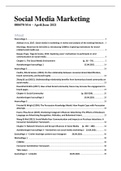Social Media Marketing
880478-M-6 – April/June 2021
Inhoud
Hoorcollege 1 .......................................................................................................................................... 3
Alalwan et al, 2017. Social media in marketing: A review and analysis of the existing literature .. 3
Muntinga, Moorman & Smit (2011). Introducing COBRAs: Exploring motivations for brand-
related social media use ..................................................................................................................... 3
Borges-Tiago, Tiago & Cosme, 2019. Exploring users' motivations to participate in viral
communication on social media. ....................................................................................................... 4
Chapter 1: The Social Media Environment (p. 26 – 79) .................... 5
Aantekeningen hoorcollege 1 12.04.2021 ................ 14
Hoorcollege 2 ........................................................................................................................................ 18
Coelho, Rita & Santos. (2018). On the relationship between consumer-brand identification,
brand community, and brand loyalty .............................................................................................. 18
Zhang & Luo (2015). Understanding relationship benefits from harmonious brand community on
social media. ..................................................................................................................................... 19
Rosenthal & Brito (2017). How virtual brand community traces may increase fan engagement in
brand pages....................................................................................................................................... 19
Chapter 6: Social Community (p. 282-328).................... 20
Aantekeningen hoorcollege 2 19.04.2021 ................ 28
Hoorcollege 3 ........................................................................................................................................ 33
Friestad & Wright (1994). The Persuasion Knowledge Model: How People Cope with Persuasion
Attempts ........................................................................................................................................... 33
Evans, Phua & Jun (2017). Disclosing Instagram Influencer Advertising: The Effects of Disclosure
Language on Advertising Recognition, Attitudes, and Behavioral Intent....................................... 33
Wang & Wei (2012). Social Media Peer Communication and Impacts on Purchase Intentions: A
Consumer Socialization Framework................................................................................................. 34
Chapter 3: Network Structure and Group Influences in Social Media (p. 130 – 180) ................ 34
Aantekeningen hoorcollege 3 – Kenmerken van social media marketing 2 22.04.2021............. 41
Gastcollege 1 – Creëer krachtige content voor Instagram 28.04.2021 ...................................... 46
Werkcollege 1 ....................................................................................................................................... 48
COBRAS ............................................................................................................................................. 48
Consumer Socialization Framework................................................................................................. 48
Take aways ........................................................................................................................................ 48
Gastcollege 2 – LinkedIn 18.05.2021 .......................................... 49
,Werkcollege 2 ....................................................................................................................................... 49
Djafarova & Rushworth. (2017). Exploring the credibility of online celebrities' Instagram profiles
in influencing the purchase decisions of young female users......................................................... 49
Jin & Ryu. (2020). “I’ll buy what she’s #wearing”: The roles of envy toward and parasocial
interaction with influencers in Instagram celebrity-based brand endorsement and social
commerce ......................................................................................................................................... 49
Schouten, Janssen & Verspaget. (2020). Celebrity vs. Influencer endorsements in advertising: the
role of identification, credibility, and Product-Endorser fit ............................................................ 49
De Veirman, Cauberghe & Hudders. (2017). Marketing through Instagram influencers: the impact
of number of followers and product divergence on brand attitude .............................................. 50
Hoorcollege 4 – Kenmerken van Social Media Marketing 3 ............................................................... 50
Vashisht & Pillai. (2015). Are you able to recall the brand? The impact of brand prominence,
game involvement and persuasion knowledge in online – advergames........................................ 50
Antheunis & Van Noort. (2011). Interactivity effects in social network site campaigning:
Personalization as the driving force behind brand engagement .................................................... 50
Walrave et al. (2018). Like or dislike? Adolescents’ responses to personalized social network site
advertising ........................................................................................................................................ 51
Chapter 2: Social Consumers (p. 79 – 129) ................... 51
Chapter 8: Social Entertainment (p. 379 – 429) .................. 63
Aantekeningen hoorcollege 4 – Kenmerken van social media marketing 3 17.05.2021............. 73
Hoorcollege 5 – XXXXXXXXXXXXXX...................................................................................................... 79
Nanne, Antheunis & van Noort. (2021). The role of facial expression and tie strength in sender
presence effects on consumers’ brand responses towards visual brand-related user generated
content. ............................................................................................................................................. 79
Hansen, Kupfer & Hennig-Thurau. (2018). Brand crises in the digital age: The short- and long-
term effects of social media firestorms on consumers and brands ................................................ 79
Chapter 10: Social Media Analytics (p. 477 – 517)................... 79
Chapter 11: Social Media Metrics (p. 518 – 561) .................. 85
Aantekeningen hoorcollege 5 – XXXXXX 20.05.2021.................................................................... 91
Gastcollege 3 – XXXXXXXXXXXXXX 26.05.2021 .......................................................................... 97
Werkcollege 3 – XXXXXXXXXXXXXX ................................................................................................... 100
Ebrahim,. (2019). The Role of Trust in Understanding the Impact of Social Media Marketing on
Brand Equity and Brand Loyalty ..................................................................................................... 100
Aantekeningen werkcollege 3 – XXXXXXX 26.05.2021.................................................................. 100
,Hoorcollege 1
Alalwan et al, 2017. Social media in marketing: A review and analysis of the existing
literature
Systematically examines and reviews the current studies that have conducted over the related area of
social media and marketing.
• Reviews 144 articles.
• Researchers provided an overview of the main themes and trends covered by the relevant
literature, such as:
o The role of social media on advertising.
o The electronic word of mouth.
o Customers' relationship management.
o Firms' brands and performance.
• De focus ligt in het artikel op literatuur over de implicatie van social media binnen marketing.
• Ze hebben gebruik gemaakt van de concept-driven systematic review approach (Webster en
Watson, 2002). --> examines the literature from the concepts perspective presented by all
authors.
• Gebruikte artikelen hadden verschillende thema's en zijn onderverdeeld in subgroepen:
o Articles that have addressed the role of social media in predicting the advertising
activities.
o Articles that have examined how social media can influence the electric word of
mouth (e-WOM).
o Articles that have tested how using social media could impact the customer
relationship management (CRM).
o Articles that have paid attention to brand issues over the social media platforms.
o Articles that have examined how social media could predict consumer behavior as a
source of information.
o Articles that have examined factors that influence the customer adoption of social
media.
o Articles that have addressed the role of social media from the organizations'
perspectives.
Muntinga, Moorman & Smit (2011). Introducing COBRAs: Exploring motivations for
brand-related social media use
• Makes a first effort to come to an
understanding of people's motivations to
engage in brand-related social media use to
effectively anticipate the consequences of
online brand-related activities (COBRAs).
• Consuming has the lowest level of brand-
related activeness. It is driven by three
motivational dimensions:
o Information
o Entertainment
o Remuneration.
• Contributing is driven by three motivations:
o Personal identity
o Integration and social interaction
o Entertainment
, • Creating has the highest level of brand-related activeness.
• Driven by the same three motivational dimensions as contributing:
o Personal identity
o Integration and social interaction
o Entertainment
Borges-Tiago, Tiago & Cosme, 2019. Exploring users' motivations to participate in
viral communication on social media.
• Seeks to understand the conditions under which social-media users adopt sharing behaviors
concerning content promoted by companies.
• First major viral event promoted on Facebook was used as a unit of analysis.
o Additionally, Facebook users were questioned regarding their Facebook persona,
social-media usage, opinion-leadership/information-seeking tendencies, levels of
disclosed/withheld information on Facebook, and emotional and cognitive needs.
• Data was gathered from an online survey of Facebook users, focusing on a case study of a
Facebook event.
o Snowball sampling.
o Non-probability technique.
• Results identified three types of social network users:
o Heavy users
o Social-driven users
o Search-driven users > most likely to promote viral content
• Significant differences between heavy users and social-driven users regarding the effect of
peers' influence on user willingness to share content, content arousal on attitude towards viral
communication, and of content meaningfulness on attitude.
• Significant differences between social-driven and research-driven users concerning the effect
of content meaningfulness on attitude.
• Results suggest that social pressures have a greater influence on Heavy Users, reinforcing the
notion that more established digital social personas are most likely to participate in viral
communication.
• This study demonstrates that attitude toward a viral communication has a negative impact on
user willingness to engage with and share such content, particularly less intensive social-
network users.
• Content characteristics, such as meaningfulness, emotional tone, and arousal, are relevant to
individuals' attitudes toward viral communication.
• Further, heavy users are more likely to participate in a sharing event, motivated by social
pressures.
• Thus, users are less likely to participate than share content, and are greatly influenced by
content characteristics.
• Results highlight the need to consider content meaningfulness when designing a viral-
communication strategy.
• The results also show that attitudes toward Facebook's viral campaigns significantly influence
viral communication through this social medium. However, the predictor dimensions have
differing levels of influence on sharing behaviors. It seems reasonable to postulate that
successful viral-communication campaigns on Facebook should focus more on the
predominant dimensions identified to be most closely related to sharing content during peak
diffusion; in particular, the main reported reason for sharing content was that peers were
sharing it.






